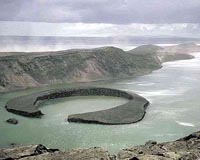| . |  |
. |
Corvallis OR (SPX) Aug 04, 2010 A new study has found that a mixing of two different types of magma is the key to the historic eruptions of Mount Hood, Oregon's tallest mountain, and that eruptions often happen in a relatively short time - weeks or months - after this mixing occurs. This behavior is somewhat different than that of most other Cascade Range volcanoes, researchers said, including Mount Hood's nearby, more explosive neighbor, Mount St. Helens. The research is being reported this week in Nature Geoscience by geologists from Oregon State University and the University of California at Davis, in work supported by the National Science Foundation. It will help scientists better understand the nature of Mount Hood's past and future eruptions, as well as other volcanoes that erupt by similar mechanisms. This includes a large number of the world's active volcanoes. "These data will help give us a better road map to what a future eruption on Mount Hood will look like, and what will take place before it occurs," said Adam Kent, an OSU associate professor of geosciences. "It should also help us understand the nature of future eruptions and what risks they will entail." Mount Hood, at 11,249 feet tall, is the highest mountain in Oregon and fourth highest in the Cascade Range. The last major eruption was in the late 1780's, and the effects of this eruption where viewed by members of the Lewis and Clark Expedition in 1805. It is considered potentially active and the Oregon volcano most likely to erupt, although the chances of that are still small. Geologists are already able to use things like gas emissions, the chemistry of hot springs, ground deformation, local earthquakes and other data to help predict when a volcanic eruption is imminent, Kent said, and the new findings will add even more data toward that goal. Two types of magma, or molten underground rock, are often involved in volcanic processes - mafic magma, which has less silica and is more fluid; and felsic magma, which has a higher silica content and a thicker consistency, like toothpaste. A third type of magma, called andesite, named after the Andes Mountains where it is often found, is composed of a mixture of both felsic and mafic magma. Andesite is common in volcanoes that form at subduction zones - regions where one tectonic plate is sinking below another - and include those that form around the well-known Pacific Ocean "rim of fire". The rocks around Mount Hood, scientists say, are almost exclusively formed from andesitic magma. And research suggests that the recharge of mafic magma to mix with its thicker felsic counterpart often occurs just prior to an actual eruption. "The intense mixing of these two types of magma causes an increase in pressure and other effects, and is usually the trigger for an eruption," Kent said. "But this process doesn't happen in all volcanic events. In the Cascade Range, Mount Hood appears to be one volcano where andesitic magma and recharge-driven eruptions are dominant." That may be because of local crustal conditions, Kent said. Even though the Cascade Range is linked to melting rock from the Cascadia Subduction Zone, some parts of the crust are more difficult than others for magma to move through. Mount Hood appears to be in a region where it takes the extra pressure of magma mixing to cause an eruption. Kent said that researchers study these processes not only to improve their ability to predict eruptions, and to recognize precursors to eruption, but also to assess possible ore deposits associated with volcanic activity, and learn more about the fundamental dynamics of volcanic processes.
Share This Article With Planet Earth
Related Links Oregon State University Bringing Order To A World Of Disasters When the Earth Quakes A world of storm and tempest
 Stiff penalties for Philippine volcano tourism
Stiff penalties for Philippine volcano tourismManila (AFP) June 13, 2010 The tourist trade faces strict penalties for allowing visitors onto a volcano island near the Philippine capital after it began to show signs that it might erupt, the coastguard said on Sunday. Resort and boat operators who violate the ban by bringing tourists to Taal may have their vessels confiscated and their resorts closed, said Captain Frankelino Phaeton. "They (the tourists) are cu ... read more |
|
| The content herein, unless otherwise known to be public domain, are Copyright 1995-2010 - SpaceDaily. AFP and UPI Wire Stories are copyright Agence France-Presse and United Press International. ESA Portal Reports are copyright European Space Agency. All NASA sourced material is public domain. Additional copyrights may apply in whole or part to other bona fide parties. Advertising does not imply endorsement,agreement or approval of any opinions, statements or information provided by SpaceDaily on any Web page published or hosted by SpaceDaily. Privacy Statement |